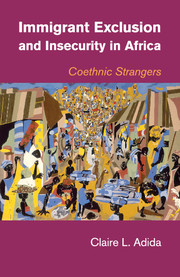Book contents
- Frontmatter
- Dedication
- Contents
- List of Figures
- List of Tables
- Acknowledgments
- 1 Introduction
- 2 Immigrants and Their Leaders
- 3 Immigrant Exclusion from Host Societies
- 4 Alternative Explanations
- 5 Mass Immigrant Expulsions in Africa
- 6 Conclusion
- Appendix A Constructing the Immigrant Attachment Index
- Appendix B Constructing the Cultural Overlap Index
- Appendix C List of Mass Expulsions and Variable Description
- Bibliography
- Index
5 - Mass Immigrant Expulsions in Africa
Published online by Cambridge University Press: 05 July 2014
- Frontmatter
- Dedication
- Contents
- List of Figures
- List of Tables
- Acknowledgments
- 1 Introduction
- 2 Immigrants and Their Leaders
- 3 Immigrant Exclusion from Host Societies
- 4 Alternative Explanations
- 5 Mass Immigrant Expulsions in Africa
- 6 Conclusion
- Appendix A Constructing the Immigrant Attachment Index
- Appendix B Constructing the Cultural Overlap Index
- Appendix C List of Mass Expulsions and Variable Description
- Bibliography
- Index
Summary
Samuel was born in the late 1950s in Kumasi, the capital of the Ashanti Region in what was then called the Gold Coast and what is today known as Ghana. His parents traveled from Ogbomosho in Nigeria to Ghana in the early 1930s to sell traditional Yoruba cloth. Samuel was schooled in a public school in Kumasi, where he learned the indigenous Ghanaian Ashanti language, Twi. When Samuel speaks Twi, no one can tell and no one even believes that he is of Nigerian background. In Kumasi, he and his parents attended the First Baptist Church, just like they did back in Ogbomosho, to pray with fellow Yorubas in the Yoruba language.
In November 1969, Ghana's Prime Minister Kofi Busia issued an Alien Compliance Order, giving Ghana's aliens two weeks to acquire a residence permit or leave the country. Immediately, Samuel left with his parents and siblings. They did not even try to obtain their residence permit because “during that time, most people were fearing for their lives … at the time, people would say ‘you are aliens, go to your country!’”
Between 1956 and 1999, more than 50 percent of all sub-Saharan African countries have gone through at least one mass immigrant expulsion, affecting a total of approximately 3.8 million people. South Africa, Nigeria, Côte d'Ivoire, Kenya, Sierra Leone, and Uganda provide examples of countries that issued at least two mass expulsions between their independence and 1999. By contrast, Rwanda, Togo, Zimbabwe, Malawi, and Mali never resorted to such violence. The Democratic Republic of the Congo, with five expulsions, is the worst offender.
- Type
- Chapter
- Information
- Immigrant Exclusion and Insecurity in AfricaCoethnic Strangers, pp. 118 - 145Publisher: Cambridge University PressPrint publication year: 2014
- 1
- Cited by

